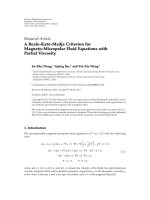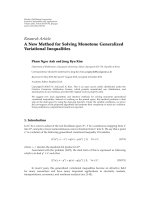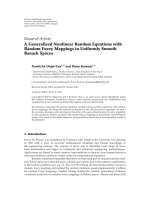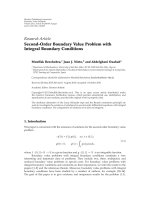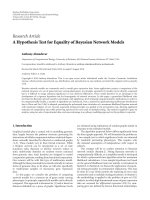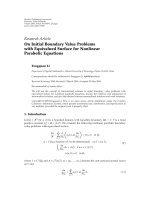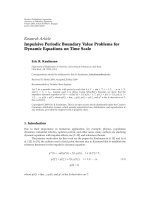Báo cáo hóa học: "Research Article A Fourth-Order Boundary Value Problem with One-Sided Nagumo Condition" ppt
Bạn đang xem bản rút gọn của tài liệu. Xem và tải ngay bản đầy đủ của tài liệu tại đây (513.97 KB, 13 trang )
Hindawi Publishing Corporation
Boundary Value Problems
Volume 2011, Article ID 569191, 13 pages
doi:10.1155/2011/569191
Research Article
A Fourth-Order Boundary Value Problem with
One-Sided Nagumo Condition
Wenjing Song
1, 2
and Wenjie Gao
1
1
Institute of Mathematics, Jilin University, Changchun 130012, China
2
Institute of Applied Mathematics, Jilin University of Finance and Economics, Changchun 130017, China
Correspondence should be addressed to Wenjing Song,
Received 10 January 2011; Accepted 9 March 2011
Academic Editor: I. T. Kiguradze
Copyright q 2011 W. Song and W. Gao. This is an open access article distributed under the
Creative Commons Attribution License, which permits unrestricted use, distribution, and
reproduction in any medium, provided the original work is properly cited.
The aim of this paper is to study a fourth-order separated boundary value problem with the right-
hand side function satisfying one-sided Nagumo-type condition. By making a series of a priori
estimates and applying lower and upper functions techniques and Leray-Schauder degree theory,
the authors obtain the existence and location result of solutions to the problem.
1. Introduction
In this paper we apply the lower and upper functions method to study the fourth-order
nonlinear equation
u
4
t
f
t, u
t
,u
t
,u
t
,u
t
, 0 <t<1
, 1.1
with f : 0, 1 ×
4
→ being a continuous function.
This equation can be used to model the deformations of an elastic beam, and the type of
boundary conditions considered depends on how the beam is supported at the two endpoints
1, 2. We consider the separated boundary conditions
u
0
u
1
0,
au
0
− bu
0
A,
cu
1
du
1
B
1.2
with a, b, c, d ∈
0, ∞, A, B ∈ .
2 Boundary Value Problems
For the fourth-order differential equation
u
4
t
f
t, u
t
,u
t
,u
t
,u
t
, 0 <t<1,
u
0
u
1
u
0
u
1
,
1.3
the authors in 3 obtained the existence of solutions with the assumption that f satisfies the
two-sided Nagumo-type conditions. For more related works, interested readers may refer to
1–14. The one-sided Nagumo-type condition brings some difficulties in studying this kind
of problem, as it can be seen in 15–18.
Motivated by the above works, we consider the existence of solutions when f
satisfies one-sided Nagumo-type conditions. This is a generalization of the above cases.
We apply lower and upper functions technique and topological degree method to prove
the existence of solutions by making a priori estimates for the third derivative of all
solutions of problems 1.1 and 1.2. The estimates are essential for proving the existence of
solutions.
The outline of this paper is as follows. In Section 2, we give the definition of lower
and upper functions to problems 1.1 and 1.2 and obtain some a priori estimates. Section 3
will be devoted to the study of the existence of solutions. In Section 4, we give an example to
illustrate the conclusions.
2. Definitions and A Priori Estimates
Upper and lower functions will be an important tool to obtain a priori bounds on u, u
,and
u
. For this problem we define them as follows.
Definition 2.1. The functions α, β ∈ C
4
0, 1 ∩ C
3
0, 1 verifying
α
t
≤ β
t
, ∀t ∈
0, 1
, 2.1
define a pair of lower and upper functions of problems 1.1 and 1.2 if the following
conditions are satisfied:
i α
4
t ≥ ft, αt,α
t,α
t,α
t, β
4
t ≤ ft, βt,β
t,β
t,β
t,
ii α0 ≤ 0,α1 ≤ 0,aα
0 − bα
0 ≤ A, cα
1dα
1 ≤ B, β0 ≥ 0 ,β1 ≥
0,aβ
0 − bβ
0 ≥ A, cβ
1dβ
1 ≥ B,
iii α
0 − β
0 ≤ min{β0 − β1,α1 − α0, 0}.
Remark 2.2. By integration, from iii and 2.1,weobtain
α
t
≤ β
t
,α
t
≤ β
t
, ∀t ∈
0, 1
, 2.2
that is, lower and upper functions, and their first derivatives are also well ordered.
To have an a priori estimate on u
, we need a one-sided Nagumo-type growth
condition, which is defined as follows.
Boundary Value Problems 3
Definition 2.3. Given a set E ⊂ 0, 1 ×
4
, a continuous f : E → is said to satisfy the
one-sided Nagumo-type condition in E if there exists a real continuous function h
E
:
0
→
k, ∞,forsomek>0, such that
f
t, x
0
,x
1
,x
2
,x
3
≤ h
E
|
x
3
|
, ∀
t, x
0
,x
1
,x
2
,x
3
∈ E, 2.3
with
∞
0
s
h
E
s
ds ∞.
2.4
Lemma 2.4. Let Γ
i
t,γ
i
t ∈ C0, 1, satisfy
Γ
i
t
≥ γ
i
t
, ∀t ∈
0, 1
,i 0, 1, 2, 2.5
and consider the set
E
t, x
0
,x
1
,x
2
,x
3
∈
0, 1
×
4
: γ
i
t
≤ x
i
≤ Γ
i
t
,i 0, 1, 2
. 2.6
Let f : 0, 1 ×
4
→ be a continuous function satisfying one-sided Nagumo-type condition in E.
Then, for every ρ>0,thereexistsanR>0 such that for every solution ut of problems 1.1
and 1.2 with
u
0
≤ ρ, u
1
≥−ρ, 2.7
γ
i
t
≤ u
i
t
≤ Γ
i
t
,
2.8
for i 0, 1, 2 and every t ∈ 0, 1,onehasu
∞
<R.
Proof. Let u be a solution of problems 1.1 and 1.2 such that 2.7 and 2.8 hold. Define
η : max
Γ
2
1
− γ
2
0
, Γ
2
0
− γ
2
1
. 2.9
Assume that ρ ≥ η, and suppose, for contradiction, that |u
t| >ρfor every t ∈ 0, 1.
If u
t >ρfor every t ∈ 0, 1, then we obtain the following contradiction:
Γ
2
1
− γ
2
0
≥ u
1
− u
0
1
0
u
t
dt >
1
0
ρdt≥ Γ
2
1
− γ
2
0
.
2.10
If u
t < −ρ for every t ∈ 0, 1, a similar contradiction can be derived. So there is a
t ∈ 0, 1
such that |u
t|≤ρ.By2.4 we can take R
1
>ρsuch that
R
1
ρ
s
h
E
s
ds > max
t∈0,1
Γ
2
t
− min
t∈0,1
γ
2
t
.
2.11
4 Boundary Value Problems
If |u
t|≤ρ for every t ∈ 0, 1, then we have trivially |u
t| <R
1
.Ifnot,thenwecan
take t
1
∈ 0, 1 such that u
t
1
< −ρ or t
1
∈ 0, 1 such that u
t
1
>ρ. Suppose that the first
case holds. By 2.7 we can consider t
1
<t
0
≤ 1suchthat
u
t
0
−ρ, u
t
< −ρ, ∀t ∈
t
1
,t
0
. 2.12
Applying a convenient change of variable, we have, by 2.3 and 2.11,
−u
t
1
−u
t
0
s
h
E
s
ds
t
1
t
0
−u
t
h
E
−u
t
−u
4
t
dt
t
0
t
1
−u
t
h
E
−u
t
f
t, u
t
,u
t
,u
t
,u
t
dt
≤
t
0
t
1
−u
t
dt u
t
1
− u
t
0
≤ max
t∈0,1
Γ
2
t
− min
t∈0,1
γ
2
t
<
R
1
ρ
s
h
E
s
ds.
2.13
Hence, u
t
1
> −R
1
.Sincet
1
can be taken arbitrarily as long as u
t
1
< −ρ,weconcludethat
u
t > −R
1
for every t ∈ 0, 1 provided that u
t < −ρ.
In a similar way, it can be proved that u
t <R
1
, for every t ∈ 0, 1 if u
t >ρ.
Therefore,
u
t
<R
1
, ∀t ∈
0, 1
. 2.14
Consider now the case η>ρ,andtakeR
2
>ηsuch that
R
2
η
s
h
E
s
ds > max
t∈0,1
Γ
2
t
− min
t∈0,1
γ
2
t
.
2.15
In a similar way, we may show that
u
t
<R
2
, ∀t ∈
0, 1
. 2.16
Taking R ma x{R
1
,R
2
},wehaveu
∞
<R.
Remark 2.5. Observe that the estimation R depends only on the functions h
E
, γ
2
, Γ
2
,andρ and
it does not depend on the boundary conditions.
3. Existence and Location Result
In the p resence o f a n ordered pair of lower and upper functions, the existence and location
results for problems 1.1 and 1.2 can be obtained.
Boundary Value Problems 5
Theorem 3.1. Suppose that there exist lower and upper functions αt and βt of problems 1.1
and 1.2, r espectively. Let f : 0, 1 ×
4
→ be a continuous function satisfying the one-sided
Nagumo-type conditions 2.3 and 2.4 in
E
∗
t, x
0
,x
1
,x
2
,x
3
∈
0, 1
×
4
: α
t
≤ x
0
≤ β
t
,α
t
≤ x
1
≤ β
t
,α
t
≤ x
2
≤ β
t
3.1
If f verifies
f
t, α
t
,α
t
,x
2
,x
3
≥ f
t, x
0
,x
1
,x
2
,x
3
≥ f
t, β
t
,β
t
,x
2
,x
3
3.2
for t, x
2
,x
3
∈ 0 , 1 ×
2
and
α
t
,α
t
≤
x
0
,x
1
≤
β
t
,β
t
, 3.3
where x
0
,x
1
≤ y
0
,y
1
means x
0
≤ y
0
and x
1
≤ y
1
,thenproblems1.1 and 1.2 has at least one
solution ut ∈ C
4
0, 1 satisfying
α
t
≤ u
t
≤ β
t
,α
t
≤ u
t
≤ β
t
,α
t
≤ u
t
≤ β
t
3.4
for t ∈ 0, 1.
Proof. Define the auxiliary functions
δ
i
t, x
i
⎧
⎪
⎪
⎪
⎪
⎨
⎪
⎪
⎪
⎪
⎩
α
i
t
,x
i
<α
i
t
,
x
i
,α
i
t
≤ x
i
≤ β
i
t
,
β
i
t
,x
i
>β
i
t
.
i 0, 1, 2, 3.5
For λ ∈ 0, 1, consider the homotopic equation
u
4
t
λf
t, δ
0
t, u
t
,δ
1
t, u
t
,δ
2
t, u
t
,u
t
u
t
− λδ
2
t, u
t
,
3.6
with the boundary conditions
u
0
u
1
0,
u
0
λ
b
au
0
− A
,
u
1
λ
d
B − cu
1
.
3.7
6 Boundary Value Problems
Take r
1
> 0 large enough such that, for every t ∈ 0, 1,
−r
1
<α
t
≤ β
t
<r
1
, 3.8
f
t, α
t
,α
t
,α
t
, 0
− r
1
− α
t
< 0, 3.9
f
t, β
t
,β
t
,β
t
, 0
r
1
− β
t
> 0, 3.10
|
A
|
a
<r
1
,
|
B
|
c
<r
1
.
3.11
Step 1. Every solution ut of problems 3.6 and 3.7 satisfies
u
i
t
<r
1
, ∀t ∈
0, 1
3.12
for i 0, 1, 2, for some r
1
independent of λ ∈ 0, 1.
Assume, for contradiction, that the above estimate does not hold for i 2. So there
exist λ ∈ 0, 1, t ∈ 0, 1,andasolutionu of 3.6 and 3.7 such that |u
t|≥r
1
.Inthecase
u
t ≥ r
1
define
max
t∈0,1
u
t
: u
t
0
≥ r
1
.
3.13
If t
0
∈ 0, 1,thenu
t
0
0andu
4
t
0
≤ 0. Then, by 3.2 and 3.10,forλ ∈ 0, 1,
the following co ntradiction is obtained:
0 ≥ u
4
t
0
λf
t
0
,δ
0
t
0
,u
t
0
,δ
1
t
0
,u
t
0
,δ
2
t
0
,u
t
0
,u
t
0
u
t
0
− λδ
2
t
0
,u
t
0
λf
t
0
,δ
0
t
0
,u
t
0
,δ
1
t
0
,u
t
0
,β
t
0
, 0
u
t
0
− λβ
t
0
≥ λf
t
0
,β
t
0
,β
t
0
,β
t
0
, 0
u
t
0
− λβ
t
0
λ
f
t
0
,β
t
0
,β
t
0
,β
t
0
, 0
r
1
− β
t
0
u
t
0
− λr
1
> 0.
3.14
For λ 0,
0 ≥ u
4
t
0
u
t
0
≥ r
1
> 0.
3.15
If t
0
0, then
max
t∈0,1
u
t
: u
0
≥ r
1
> 0
3.16
and u
0
u
0 ≤ 0. If λ 0, then u
00andsou
4
0 ≤ 0. Therefore, the above
computations with t
0
replaced by 0 yield a contradiction. For λ ∈ 0, 1,by3.11,wegetthe
Boundary Value Problems 7
following contradiction:
0 ≥ u
0
λ
b
au
0
− A
≥
λ
b
ar
1
− A
> 0.
3.17
The case t
0
1 is analogous. Thus, u
t <r
1
for every t ∈ 0, 1. In a simila r way, we
may prove that u
t > −r
1
for every t ∈ 0, 1.
By the boundary condition 3.7 there exists a ξ ∈ 0, 1,suchthatu
ξ0. Then by
integration we obtain
u
t
t
ξ
u
s
ds
<r
1
|
t − ξ
|
≤ r
1
,
|
u
t
|
t
0
u
s
ds
<r
1
t ≤ r
1
.
3.18
Step 2. There is an R>0 such that for every solution ut of problems 3.6 and 3.7
u
t
<R, ∀t ∈
0, 1
, 3.19
with R independent of λ ∈ 0, 1.
Consider the set
E
r
1
t, x
0
,x
1
,x
2
,x
3
∈
0, 1
×
4
: −r
1
≤ x
i
≤ r
1
,i 0, 1, 2
3.20
and for λ ∈ 0, 1 the function F
λ
: E
r
1
→ given by
F
λ
t, x
0
,x
1
,x
2
,x
3
λf
t, δ
0
t, x
0
,δ
1
t, x
1
,δ
2
t, x
2
,x
3
x
2
− λδ
2
t, x
2
. 3.21
In the following we will pr ove that the function F
λ
satisfies the one-sided Nagumo-type
conditions 2.3 and 2.4 in E
r
1
independently of λ ∈ 0, 1. Indeed, as f verifies 2.3 in
E
∗
,then
F
λ
t, x
0
,x
1
,x
2
,x
3
λf
t, δ
0
t, x
0
,δ
1
t, x
1
,δ
2
t, x
2
,x
3
x
2
− λδ
2
t, x
2
≤ h
E
∗
|
x
3
|
r
1
− λα
t
≤ h
E
∗
|
x
3
|
2r
1
.
3.22
So, defining h
E
r
1
th
E
∗
|x
3
|2r
1
in
0
,weseethatF
λ
verifies 2.3 with E and h
E
replaced
by E
r
1
and h
E
r
1
, respectively. The condition 2.4 is also verified since
∞
0
s
h
E
r
1
s
ds
∞
0
s
h
E
∗
s2r
1
ds ≥
1
1 2r
1
/k
∞
0
s
h
E
∗
s
ds ∞.
3.23
8 Boundary Value Problems
Therefore, F
λ
satisfies the one-sided Nagumo-type condition in E
r
1
with h
E
replaced by h
E
r
1
,
with r
1
independent of λ ∈ 0, 1.
Moreover, for
ρ : max
ar
1
|
A
|
b
,
|
B
|
cr
1
d
, 3.24
every solution u of 3.6 and 3.7 satisfies
u
0
λ
b
au
0
− A
≤
λ
b
ar
1
|
A
|
≤ ρ,
u
1
λ
d
B − cu
1
≥−
λ
d
|
B
|
cr
1
≥−ρ.
3.25
Define
γ
i
t
: −r
1
, Γ
i
t
: r
1
, for i 0, 1, 2. 3.26
The hypotheses of Lemma 2.4 are satisfied with E replaced by E
r
1
.SothereexistsanR>0,
depending on r
1
and h
E
r
1
,suchthat|u
t| <Rfor every t ∈ 0, 1.Asr
1
and h
E
r
1
do not
depend on λ,weseethatR is maybe independent of λ.
Step 3. For λ 1, the problems 3.6 and 3.7 has at least one solution u
1
t.
Define the operators
L : C
4
0, 1
⊂ C
3
0, 1
−→ C
0, 1
×
4
3.27
by
Lu
u
4
− u
,u
0
,u
1
,u
0
,u
1
3.28
and for λ ∈ 0, 1, N
λ
: C
3
0, 1 → C0, 1 ×
4
by
N
λ
u
λf
t, δ
0
t, u
t
,δ
1
t, u
t
,δ
2
t, u
t
,u
t
− λδ
2
t, u
t
, 0, 0,A
λ
,B
λ
, 3.29
with
A
λ
:
λ
b
au
0
− A
,
B
λ
:
λ
d
B − cu
1
.
3.30
Boundary Value Problems 9
Observe that L has a compact inverse. Therefore, we can consider the completely continuous
operator
T
λ
:
C
3
0, 1
,
−→
C
3
0, 1
,
3.31
given by
T
λ
u
L
−1
N
λ
u
.
3.32
For R given by Step 2,taketheset
Ω
x ∈ C
3
0, 1
:
x
i
∞
<r
1
,i 0, 1, 2,
x
∞
<R
.
3.33
By Steps 1 and 2,degreedI−T
λ
, Ω, 0 is well defined for every λ ∈ 0, 1 and by the invariance
with respect to a homotopy
d
I − T
0
, Ω, 0
d
I − T
1
, Ω, 0
. 3.34
The equation x T
0
x is equivalent to the problem
u
4
t
u
t
,
u
0
u
1
u
0
u
1
0
3.35
and has only the trivial solution. Then, by the degree theory,
d
I − T
0
, Ω, 0
±1. 3.36
So the equation T
1
xx has at least one solution, and therefore the equivalent problem
u
4
t
f
t, δ
0
t, u
t
,δ
1
t, u
t
,δ
2
t, u
t
,u
t
u
t
− δ
2
t, u
t
,
u
0
u
1
0,
au
0
− bu
0
A,
cu
1
du
1
B
3.37
has at least one solution u
1
t in Ω.
Step 4. The function u
1
t is a solution of the problems 1.1 and 1.2.
10 Boundary Value Problems
The proof will be finished if the above function u
1
t satisfies the inequalities
α
t
≤ u
1
t
≤ β
t
,α
t
≤ u
1
t
≤ β
t
,α
t
≤ u
1
t
≤ β
t
. 3.38
Assume, for contradiction, that there is a
t ∈ 0, 1 such that u
1
t >β
t,anddefine
max
t∈0,1
u
1
t
− β
t
: u
1
t
2
− β
t
2
> 0.
3.39
If t
2
∈ 0, 1,thenu
1
t
2
β
t
2
and u
4
1
t
2
≤ β
4
t
2
. Therefore, by 3.2 and
Definition 2.1, we obtain the contradiction
u
4
1
t
2
f
t
2
,δ
0
t
2
,u
1
t
2
,δ
1
t
2
,u
1
t
2
,δ
2
t
2
,u
1
t
2
,u
1
t
2
u
1
t
2
− δ
2
t
2
,u
1
t
2
f
t
2
,δ
0
t
2
,u
1
t
2
,δ
1
t
2
,u
1
t
2
,β
t
2
,β
t
2
u
1
t
2
− β
t
2
≥ f
t
2
,β
t
2
,β
t
2
,β
t
2
,β
t
2
≥ β
4
t
2
.
3.40
If t
2
0, then we have
max
t∈0,1
u
1
t
− β
t
: u
1
0
− β
0
> 0,
u
1
0
− β
0
u
1
0
− β
0
≤ 0.
3.41
By Definition 2.1 this yields a contradiction
u
1
0
1
b
au
1
0
− A
>
1
b
aβ
0
− A
≥ β
0
.
3.42
Then t
2
/
0 and, by similar arguments, we prove that t
2
/
1. Thus,
u
1
t
≤ β
t
, ∀t ∈
0, 1
. 3.43
Using an analogous technique, it can be deduced that α
t ≤ u
1
t for every t ∈ 0, 1.Sowe
have
α
t
≤ u
1
t
≤ β
t
. 3.44
On the other hand, by 1.2,
0 u
1
1
− u
1
0
1
0
u
1
t
dt
1
0
u
1
0
t
0
u
1
s
ds
dt u
1
0
1
0
t
0
u
1
s
ds dt, 3.45
Boundary Value Problems 11
that is,
u
1
0
−
1
0
t
0
u
1
s
ds dt.
3.46
Applying the same technique, we have
−
1
0
t
0
β
s
ds dt −
1
0
β
t
dt β
0
β
0
− β
1
β
0
,
3.47
and then by Definition 2.1 iii, 3.44 and 3.46,weobtain
α
0
≤ β
0
− β
1
β
0
−
1
0
t
0
β
s
ds dt ≤−
1
0
t
0
u
1
s
ds dt u
1
0
,
β
0
≥ α
0
− α
1
α
0
−
1
0
t
0
α
s
ds dt ≥−
1
0
t
0
u
1
s
ds dt u
1
0
,
3.48
that is,
α
0
≤ u
1
0
≤ β
0
. 3.49
Since, by 3.44, β
t − u
1
t is nondecreasing, we have by 3.49
β
t
− u
1
t
≥ β
0
− u
1
0
≥ 0, 3.50
and, therefore, β
t ≥ u
1
t for every t ∈ 0, 1. By the monotonicity of βt − u
1
t,
β
t
− u
1
t
≥ β
0
− u
1
0
β
0
≥ 0, 3.51
and so βt ≥ u
1
t for every t ∈ 0, 1.
The inequalities u
1
t ≥ α
t and u
1
t ≥ αt for every t ∈ 0, 1 can be proved in the
same way. Then u
1
t is a solution of problems 1.1 and 1.2.
4. An Example
The following example shows the applicability of Theorem 3.1 when f satisfies only the one-
sided Nagumo-type condition.
12 Boundary Value Problems
Example 4.1. Consider now the problem
u
4
t
−
3 u
t
e
u
t
u
t
− 2
2
−
u
t
4
, 4.1
u
0
u
1
0,
u
0
− u
0
A,
u
1
u
1
B
4.2
with A, B ∈
. The nonlinear function
f
t, x
0
,x
1
,x
2
,x
3
−
3 x
0
e
x
1
x
2
− 2
2
−
x
3
4
4.3
is continuous in 0, 1 ×
4
.IfA, B ∈ −2, 2, then the functions α, β : 0, 1 → defined by
α
t
−t
2
− t, β
t
t
2
t 4.4
are, respectively, lower and upper functions of 4.1 and 4.2.Moreover,define
E
t, x
0
,x
1
,x
2
,x
3
∈
0, 1
×
4
: −t
2
− t ≤ x
0
≤ t
2
t, −2t − 1 ≤ x
1
≤ 2t 1, −2 ≤ x
2
≤ 2
.
4.5
Then f satisfies condition 3.2 and the one-sided Nagumo-type condition with h
E
|x
3
|1,
in E.
Therefore, by Theorem 3.1, ther e is at least one solution ut of Problem 4.1 and 4.2
such that, for every t ∈ 0, 1,
−t
2
− t ≤ u
t
≤ t
2
t, −2t − 1 ≤ u
t
≤ 2t 1, −2 ≤ u
t
≤ 2.
4.6
Notice that the function
f
t, x
0
,x
1
,x
2
,x
3
−
3 x
0
e
x
1
x
2
− 2
2
−
x
3
4
4.7
does not satisfy the two-sided Nagumo condition.
Acknowledgments
The authors would like to thank the referees for their valuable comments on and suggestions
regarding the original manuscript. This work was supported by NSFC 10771085,byKey
Lab of Symbolic Computation and Knowledge Engineering of Ministry of Education, and by
the 985 Program of Jilin University.
Boundary Value Problems 13
References
1 C. P. Gupta, “Existence and uniqueness theorems for the bending of an elastic beam equation,”
Applicable Analysis, vol. 26, no. 4, pp. 289–304, 1988.
2 C. P. Gupta, “Existence and uniqueness theorems for a fourth order boundary value problem of
Sturm-Liouville type,” Differential and Integral Equations, vol. 4, no. 2, pp. 397–410, 1991.
3 F. Minh
´
os, T. Gyulov, and A. I. Santos, “Existence and location result for a fourth order boundary
value problem,” Discrete and Continuous Dynamical Systems. Series A, supplement, pp. 662–671, 2005.
4 A. Cabada, M. D. R. Grossinho, and F. Minh
´
os, “On the solvability of some discontinuous third order
nonlinear differential equations with two point boundary conditions,” Journal of Mathematical Analysis
and Applications, vol. 285, no. 1, pp. 174–190, 2003.
5 A. Cabada and R. L. Pouso, “Extremal solutions of strongly nonlinear discontinuous second-order
equations with nonlinear functional boundary conditions,” Nonlinear Analysis: Theory, Methods &
Applications, vol. 42, no. 8, pp. 1377–1396, 2000.
6 A. Cabada and R. L. Pouso, “Existence results for the problem φu
ft, u, u
with nonlinear
boundary conditions,” Nonlinear Analysis: Theory, Methods & Applications, vol. 35, no. 2, pp. 221–231,
1999.
7 C. de Coster, “La m
´
ethode des sur et sous solutions dans l’
´
etude de probl
`
emes aux limites,”
D
´
epartment de Math
´
ematique, Facult
´
e des Sciences, Universit
´
e Catholique de Louvain, F
´
evrier 1994.
8 C. de Coster and P. Habets, “Upper and lower solutions in the theory of ODE boundary value
problems: classical and recent results,” in Non-Linear Analysis and Boundary Value Pr oblems for Ordinary
Differential Equations (Udine), vol. 371 of CISM Courses and L ectures, pp. 1–78, Springer, Vienna, Austria,
1996.
9 M. do Ros
´
ario Grossinho and F. M. Minh
´
os, “Existence result for some third order separated boundary
value problems,” Nonlinear Analysis: Theory, Methods & Applications, vol. 47, no. 4, pp. 2407–2418, 2001.
10 M. R. Grossinho and F. Minh
´
os, “Upper and lower solutions for h igher order boundary value
problems,” Nonlinear Studies, vol. 12, no. 2, pp. 165–176, 2005.
11 M. R. Grossinho and F. Minh
´
os, “Solvability of some higher order two-point boundary value
problems,” in Proceedings of International Conference on Differential Equations and Their Applications
(Equadiff 10), pp. 183–189, Prague, Czechoslovak, August 2001, CD-ROM papers.
12 I. T. Kiguradze a nd B. L. Shekhter, “Singular boundary value problems for second-order ordinary
differential equations,” Itogi Nauki Tekh., Ser. Sovrem. Probl. Mat., Novejshie Dostizh., vol. 30, pp. 105–
201, 1987 Russian, English translation in Journal of Soviet Mathematics, vol. 43, no. 2, pp. 2340–2417,
1988.
13 F. M. Minh
´
os and A . I. Santos, “Existence and non-existence results for two-point boundary value
problems of higher order,” in Proceedings of International Conference on Diff
erential Equations (Equadiff
2003), pp. 249–251, World Sci. Publ., Hackensack, NJ, USA, 2005.
14 M. Nagumo, “Ueber die Differentialgleichung y
fx, y, y
,” Proceedings of the Physico-Mathematical
Society of Japan, vol. 1937, no. 3, pp. 861–866, 19.
15 A. Cabada, “An overview of the lower and upper solutions method with nonlinear boundary value
conditions,” Boundary Value Problems, vol. 2011, Article ID 893753, 18 pages, 2011.
16 M. R. Grossinho, F. M. Minh
´
os, and A. I. Santos, “A third order boundary value problem with one-
sided Nagumo condition,” Nonlinear Analysis: Theory , Methods & Applications, vol. 63, no. 5–7, pp.
247–256, 2005.
17 M.R.Grossinho,F.M.Minh
´
os, and A. I. Santos, “Existence result for a third-order ODE with
nonlinear boundary conditions in presence of a sign-type Nagumo control,” Journal of Mathematical
Analysis and Applications, vol. 309, no. 1, pp. 271–283, 2005.
18 M. R. Grossinho, F. M. Minh
´
os, and A. I. Santos, “Solvability of some third-order boundary
value problems with asymmetric unbounded nonlinearities,” Nonlinear Analysis: Theory, Methods &
Applications, vol. 62, no. 7, pp. 1235–1250, 2005.
